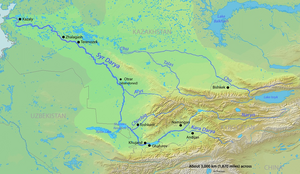Andijan
| Author:Laxman Burdak, IFS (Retd.) |

Andijan or Andizhan (Uzbek: Andijon) is the fourth-largest city in Uzbekistan, and the capital of the Andijan Province. It is located in the east of the country, at 40°47′N 72°20′E, in the Fergana Valley, near the border with Kyrgyzstan on the Andijan-Say River.
Origin of name
Arab geographers from the 10th century and later give the name as Andiyon, Andukan, Andugan, and Andigan. The etymology is unknown; the traditional explanation links it to the Turkic tribal name Andi.[1]
Jat clans
History
In the first quarter of the 13th century, Andijan was the capital of Fergana region. Both Babur, Ark Andijan wrote on its largest was in Maveraunnahre following after Samarkand and cache. At that time in Andijan also operated his mint.
Consequently, Andijan is located in one of the hotbeds of Central Asia, which appeared early farming, formed the first samples of urban culture. In this territory were the ruins of an early city Dalvarzina (9th-7th centuries BC) and the ancient city of Èjlatona (6th-3rd centuries BC). To its geopolitical location Andijan served as a bridge between Bactria, Sogdiana, Chach with China (Xinjiang).[2]
Andijan was an important stop on the Silk Road, lying roughly mid-way between Kashgar and Khodjend. Destroyed by Genghis Khan, it was rebuilt by his grandson Kaidu Khan in the late 13th century, and became the capital of Ferghana for the next three centuries. It is perhaps best known as the birthplace of Zahir-ud-din Muhammad Babur (Babur), who founded the Mughal dynasty that ruled much of today's India, Pakistan, and South Asia, born in 1483.[3][4]
Notable persons
External links
References
- ↑ E.M. Pospelov, Geograficheskie nazvaniya mira (Moscow, 1998), p. 36
- ↑ http://www.bakutoday.net/in-uzbekistan-decided-to-celebrate-the-2500-year-anniversary-of-andijan.html
- ↑ Wheeler M. (ed. & trans.) The Babur-nama
- ↑ Beatrice Forbes Manz “Central Asian Uprisings in the Nineteenth Century: Ferghana under the Russians” Russian Review Vol. 46 (1987), pp. 267-281

